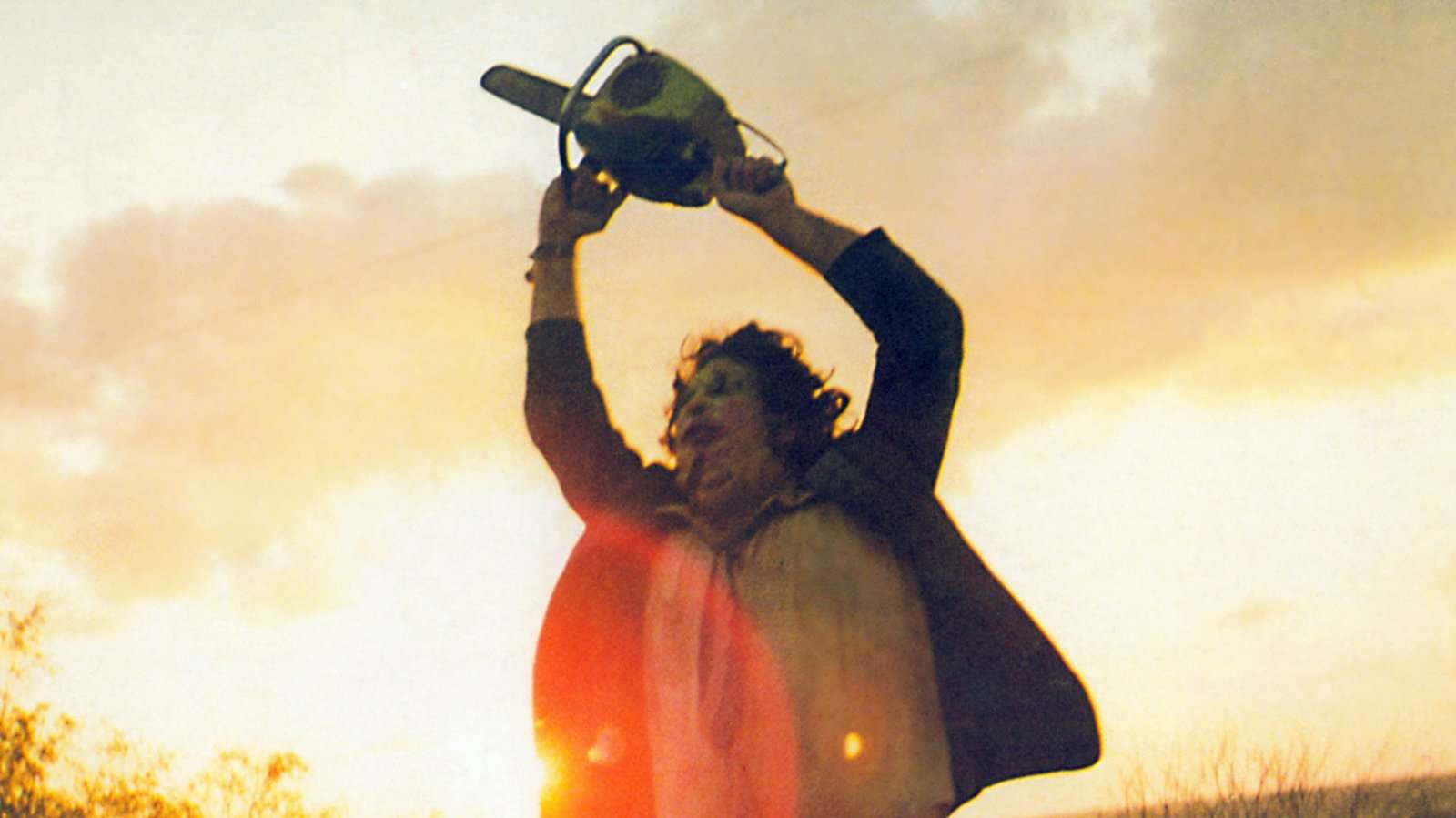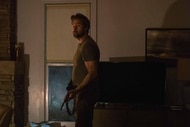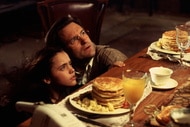Create a free profile to get unlimited access to exclusive videos, sweepstakes, and more!
Psycho, Scream and More: The True Stories Behind 17 Terrifying Horror Movies
The only thing scarier than Freddy and Leatherface are the real events that inspired them. Read more here!

The only thing scarier than the horror movies that Hollywood puts on the big screen are the real-life horrors that inspired them.
Horror classics like Psycho and The Exorcist deliver high-octane nightmare fuel scares thanks in part to their fictional stories being tethered to very real, and very frightening, events. The all-too-common "based on a true story," along with the less reliable "inspired by true events," have become ubiquitous additions to most horror movie marketing campaigns. Going back to 1974’s Texas Chain Saw Massacre, and its unsettling and unforgettable tagline — "What happened is true.
RELATED: Stream The Texas Chainsaw Massacre on Peacock
Now the motion picture that's just as real." — the truth behind the fiction helps sell tickets that make you white-knuckle your chair’s armrests.
17 scary movies based on (or at least inspired by) even scarier real events
Psycho (1960)
Alfred Hitchcock’s black-and-white classic is as timeless as its real-life origins are infamous.
The story of Norman Bates (Anthony Perkins) and his “mother” issues is said to be inspired by the story of Ed Gein, a Wisconsin man who was convicted of murder in the 1950s but is suspected of having a much higher body count. On top of being a killer, Gein was an amateur grave robber prone to making unique home decor, including a lampshade composed of human skin from a person’s face.
The Birds (1963)
Another Hitchcock classic, The Birds’ nail-biting tale of a small town struggling to survive an invasion of violent birds is based on a frightening event that occurred in a sleepy part of Santa Cruz, California.
The Birds novella — written by Daphne du Maurier — and Hitchcock’s film owe their origins to a 1961 event that briefly upended life in Santa Cruz. A local newspaper there documented a rare attack by a massive flock of seabirds; they littered the streets and front lawns after colliding with buildings and swarming citizens. The story goes that, three days after reading the newspaper’s article, Hitchcock phoned the paper to tell them that he would be using the piece as research for the terror he was about to inflict on Bodega Bay — a real town north of Santa Cruz that, luckily, hasn’t actually ever been attacked by avians.
The Exorcist (1973)
Quite possibly the most terrifying horror film ever made (and certainly one of the best), The Exorcist becomes even scarier when you consider its story about a young Washington, D.C. girl possessed by a demon is closer to truth than fiction.
William Peter Blatty, who wrote both the Oscar-winning screenplay and the bestselling 1971 novel, was first inspired by the 1949 real-life exorcism of a 14-year-old boy. A student at Georgetown University at the time, Blatty became fascinated with a Washington Post article headlined "Priest Frees Mt. Rainier Boy Reported Held in Devil's Grip." Decades later, author Thomas B. Allen wrote about the true story in a 1993 book titled Possessed: The True Story of an Exorcism. According to Allen, the young boy in the case plays with an Ouija board, much like Regan (Linda Blair) does in The Exorcist. Ultimately, two priests — like in the film — performed the rite of exorcism some 20 to 30 times to save the boy from the demonic infestation. Truly scary stuff.
The Texas Chainsaw Massacre (1974)
Another horror film loosely based on the life and crimes of killer Ed Gein, Tobe Hooper’s landmark horror film capitalized on Gein’s notorious exploits to help create one of the genre’s most iconic and terrifying figures: Leatherface.
Wearing a mask of raw human skin, similar to the ones worn by Gein’s lamps at home (cringe), Leatherface was front and center on the film’s marketing campaign — as was a “based on true events” moniker that was employed to attract a wider audience. While the plot is almost entirely fictional, despite the famous tagline, it’s no less terrifying that certain story details can be pegged to real-life horrors.
Jaws (1975)
Fans of this Steven Spielberg blockbuster, and Peter Benchley’s novel of the same name, know that Jaws is based (in part) on a true story. But not the one they are thinking of.
The film — about a great white shark terrorizing a New England beach town — owes most of its game-changing legacy not to the 1916 shark attack on the Jersey shore that is mostly associated with it, but rather a more obscure incident from 1964. In the introduction to his book, Benchley reveals that he came up with Jaws upon reading an article about fisherman Frank Mundus’ frightening encounter with a 4,500-pound great white off the shores of Long Island.
Mundus would inspire the author to create the character of Quint that Robert Shaw famously played in the film. But unlike Quint, Mundus did not get turned into chum by the shark. Instead, he harpooned the beast and dragged it out of the sea.
The Amityville Horror (1979)
Arguably the most famous horror film based on horrifying, allegedly real events, The Amityville Horror has spent more than four decades giving audiences a permanent case of night terrors with the story of a young couple and their house in Amityville, New York haunted by violent spirits.
Four years prior to the film’s release, the real-life Lutz family claimed to have suffered a fate similar to that of their fictional counterparts. Upon moving into an Amityville home one year after Ronald DeFeo Jr. murdered six of his family members there, the family reported that they experienced nearly a month’s worth of strange sounds and even stranger sights that eventually sent them fleeing from their home.
But, the Lutz family took some serious creative license of their own in their report. In the years since, their claims have been debunked. Yup — no black ooze, ecotplasm, or foul odors. And especially no cloven hoofprints left behind in the snow… seeing as how there was no snow on the ground on the day the Lutz family reported their paranormal activity. But leave it to Hollywood to not let something like the truth get in the way of telling their version of it.
Poltergeist (1982)
In producer Steven Spielberg’s Poltergeist, directed by Tobe Hooper, the Freeling family discovers their suburban home is built on a haunted burial ground and is now plagued by its violent spirits. While this movie takes place in California, the haunting that supposedly inspired its story originated 3000 miles away in New York state.
In 1958, in the town of Seaford, the Hermann family claimed to be victims of paranormal activities that would be immortalized in one of the most popular films of the 1980s. They allegedly saw bottle tops pop off on their own, along with those bottles seemingly moved by an invisible hand. Their claims went viral and dominated local and national news cycles, to the point where Life Magazine did a piece on it. Like the Freelings, the Hermanns also invited paranormal specialists into their suburban home to deal with what the supposed experts claimed to be a legit poltergeist. While these researchers were able to record some evidence of strange events, the occurrences stopped shortly after the team arrived. Thankfully, whatever the Hermanns think they say stayed around long enough to inspire one of the most chest-pounding experiences in movie history.
A Nightmare on Elm Street (1984)
A Nightmare on Elm Street director Wes Craven revealed to Vulture that the idea of teens being stalked in their sleep by Freddy Krueger came after the late filmmaker read an article in the Los Angeles Times about a Cambodian family whose young son struggled with awful, vivid night terrors. “He told his parents he was afraid that if he slept, the thing chasing him would get him, so he tried to stay awake for days at a time,” Craven revealed in an oral history about his iconic film.
Like most of the teens in Elm Street, this young boy sadly died in his sleep, likely the victim of Sudden Unexpected Nocturnal Death Syndrome rather than a ghoul wearing a glove with knives for fingers.
The Serpent and the Rainbow (1988)
While not as popular or commercially successful as his first Nightmare on Elm Street film, Craven’s underrated The Serpent and the Rainbow uses frightening real-life stories to tell its equally frightening fictional one.
The 1988 film is based on the book of the same name by Harvard Ph.D. Wade Davis. The book centers on the case of a man who had "been a zombie" for two years and was allegedly poisoned, buried alive, and revived with an herbal brew. Dr. Davis journeyed to Haiti in search of the drug used in zombification rituals. Craven's loose adaptation of Davis’ experiences takes generous, R-rated liberties, but it does remain faithful to the source material’s chilling chronicle of humanity’s universal fear of being buried alive.
The Silence of the Lambs (1991)
The only horror movie to win the Best Picture Oscar, Silence of the Lambs made Hannibal “The Cannibal” Lecter a chilling household name, while putting Thomas Harris’ bestseller and the true crime cases that inspired it into the national spotlight.
Ted Tally’s Oscar-nominated script, based on Harris’ book, used an amalgam of several real-life FBI investigations to create serial killer Buffalo Bill. Ted Bundy, like Bill, faked injuries to bait his victims. And, like Lecter, Bundy also aided in creating a criminal profile to help catch the prolific Green River Killer. As for Bill’s infamous torture pit in the bowels of his home? That aspect of Agent Clarice Starling’s prey is tied to Philadelphia serial killer Gary Heidnik, who murdered and tortured six victims in his basement.
Misery (1990)
Director Rob Reiner is responsible for two of the greatest Stephen King adaptations: Stand By Me (based on King’s short story “The Body”) and the Oscar-winning Misery. The latter is based, in part, on King’s real-life experiences following the release of his fantasy novel, The Eyes of the Dragon. The negative backlash he received from fans was so strong, King used it to fuel his return to horror fiction with the tale of popular author Paul Sheldon (James Caan) struggling to escape a crazed fan, Annie Wilkes (the Oscar-winning Kathy Bates). When Paul’s car crashes during a snowstorm, Annie rescues him — and then proceeds to confine him to a room in her home while torturing him emotionally and physically until he writes a new novel to satisfy her psychotic desires.
The fanatical Wilkes and her violent ways stem from the inner demons that plagued her creator. In 2006, King told The Paris Review that Annie was a metaphor for the author’s drug addiction. “She was my number one fan. God, she never wanted to leave."
Scream (1996)
“What’s your favorite scary movie?”
Wes Craven’s meta slasher film became a sleeper hit at the 1996 Christmas box office and a ‘90s staple, as teenager Sydney Prescott (Neve Campbell) and her friends struggle to find the Ghostface killer before his knife finds them. The only things more unsettling about Scream’s murder mystery plot are the murders that the filmmakers have said inspired it.
For Scream’s 20th anniversary in 2016, Complex did a riveting piece chronicling the horrific crimes in Florida that served as a foundation for the ones that transpired in the fictional town of Woodsboro. In August 1990, Danny Rolling would be christened the Gainesville Ripper after he, like Ghostface, used a knife to kill five students in Florida. Scream writer Kevin Williamson was housesitting in Los Angeles, watching TV, when a special about the Gainesville murders aired. According to Complex, Williamson said it freaked him out so bad that he imagined a knife-wielding killer stalking him outside the home he was a guest in. Those “not-sleeping-tonight” thoughts inspired Scream’s iconic opening scene, and paved the way for one of the most popular horror franchises in movie history.
Ravenous (1999)
A notorious box office failure when it first came out, Ravenous has since developed a small but fiercely loyal cult following thanks in part to this historical horror movie’s real-life inspirations.
Disturbing and bloody barely covers Ravenous’s take on “The Colorado Cannibal” Alfred Packer, who in 1874 confessed to murdering and (gulp) eating his fellow travelers as they struggled to traverse Colorado’s San Juan mountains during a (no pun intended) deadly winter.
Open Water (2003)
Open Water courted many shocking headlines, and a mini-controversy, when it arrived in theaters in the wake of a “based on real events” marketing campaign. The low-budget film, which featured a young couple stranded in an ocean teeming with sharks, was famous for its use of real sharks to add verisimilitude to its gritty, home-video aesthetic. The sharks used in the filming of Open Water were as real as those that threatened the film’s source material: American tourists Tom and Eileen Lonergan. They were left behind on a scuba dive off the Great Barrier Reef. It took two days for the scuba company to realize the Lonergans did not return, and the couple — like their big-screen counterparts — were never found.
Wolf Creek (2005)
Wolf Creek gave survival horror a strong boost with its ultra-violent take on Australian travelers being stalked and terrorized in the Outback. The popular horror flick from writer-director Greg McLean borrows from a series of gruesome crimes committed in his home country.
“[The killer in the movie] was based on two true killers in Australia,” McLean told Starburst Magazine. The true story element of it is where he began — he’s a combination of Bradley Murdoch and Ivan Milat. So it’s combined elements of those true characters, and then took a lot of Australian archetypal characters and cultural mythology, and wove those characters into a combination to come up with the character.”
Milat and Murdoch were found guilty for the deaths of various backpackers over the years.
The Conjuring (2013)
Before he made Aquaman, director James Wan earned his bonafides with horror fans with this modern classic of the genre. The Warrens, married paranormal investigators played by Patrick Wilson and Vera Farmiga, are based on real people who claim to have encountered and battled real supernatural threats. The actual Lorraine Warren was a consultant on the movie and insists that the haunting that plagues the terror-stricken family and their home in the film really happened.
“Whoever the spirit was,” Warren told USA Today, “she perceived herself to be mistress of the house and she resented the competition my mother posed for that position.”
Hounds of Love (2016)
This disturbing and underrated horror film centers on a teenage girl struggling to escape her crazed captors, a couple in love with each other, and the idea of getting away with homicide.
That couple is inspired by a real-life one, the Birnies. In 1986, Catherine and David Birnie, who stalked the suburbs of Perth, Australia, and committed what would be known as the Moorhouse murders, named after the street on which the Birnie’s home resided. They tortured and murdered at least four women in their house, often documenting their sadistic crimes. Catherine would go on to become Western Australia’s most high-profile serial killer.
Originally published Oct 27, 2022.


























